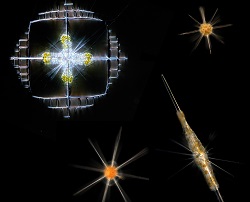Secrets of photosymbiosis revealed
Symbiosis between heterotrophic single-celled host cells and photosynthesising microalgae (photosymbiosis) is a widespread and ecologically important phenomenon among plankton living in the sunlit layers of the oceans. Symbiotic hosts can receive food from their algal symbionts. These organisms play a key role in marine biogeochemical cycles by contributing to predation and primary production. Knowledge of the diversity of symbiotic partners has recently improved but their metabolic interactions remain poorly understood. The EU-funded Horizon 2020 MINOTAUR project explored the metabolic basis of planktonic photosymbiosis, employing radiolarians as an ecological model. The aim was to better understand how this partnership functions and its contribution to elemental cycling in the pelagic ecosystem. Associations involving photosynthetic organisms are essential for providing organic carbon to oceanic water and are sinks for carbon dioxide. “These symbioses are like small factories where carbon, nitrogen, phosphorous and trace metals, essential elements for life are internally recycled. Understanding their function in the symbiosis will help us understand the mechanistic functioning and evolutionary events, like the acquisition of chloroplasts,” says project coordinator Dr Johan Decelle. Key genes and pathways revealed Researchers used high-resolution microscopy imaging to investigate and highlight morphological and metabolic mechanisms inside symbiotic cells. “This approach allows us to distinguish and quantify the physiological role of each partner at the nanoscale level, which is currently not possible using genomics methods,” explains Dr Decelle. Scientists applied an innovative single-cell approach involving stable isotopes and high-resolution chemical imaging techniques to simultaneously visualise cellular structures and identify their metabolic role. They then quantified the assimilation and transfer of nutrients between partners under different experimental conditions. The same approach was applied to free-living symbionts to determine host control over symbiont metabolism. Bioinformatic analyses are still ongoing to identify key metabolic genes and pathways from available transcriptomes of radiolarians, allowing them to develop a holistic view of metabolic interactions. The transcriptome represents the sum total of all the messenger RNA molecules expressed from the genes of the organism. Each of these techniques has its own specific programme for analysing and interpreting the data comments. “For instance, we can calculate and compare the content of nitrogen or phosphorous in different cellular structures, such as the chloroplast or the nucleus from an image obtained with nanoscale secondary ion mass spectrometry. Bioinformatic analysis is also used to process three-dimensional electron microscopy images and reconstruct the architectural organisation of cells in three dimensions,” observes Dr Decelle. Cells’ interior explored Electron microscopy observations revealed a radical morphological change to the symbiotic microalgae inside their host cell, especially their photosynthetic apparatus. “Chemical imaging allowed us to visualise and quantify the elemental and isotopic composition of cells at subcellular resolution to decipher the metabolic interactions between the host and its photosynthetic symbionts,” Dr Decelle points out. The project’s key result is the ability to observe and map nutrients and molecules inside the cells at a nanoscale resolution, which pinpoints key phenomena of the symbiotic interaction at subcellular level. “Although these organisms are widely distributed and relatively abundant in the oceans’ surface, our findings provide a first look at the interior of the cells ultrastructure and chemistry,” Dr Decelle claims. “The morphological transformation of the microalgae inside a host cell revealed by cutting-edge electron microscopy is also a significant finding.” MINOTAUR has pushed back the boundaries of marine biological research by integrating knowledge on biodiversity and physiology with ecological studies. This will provide a clearer understanding of the functioning of aquatic ecosystems and their responses to different environmental stress, such as temperature increase and nutrient limitation.
Keywords
MINOTAUR, photosymbiosis, bioinformatic, microalgae, radiolarians







